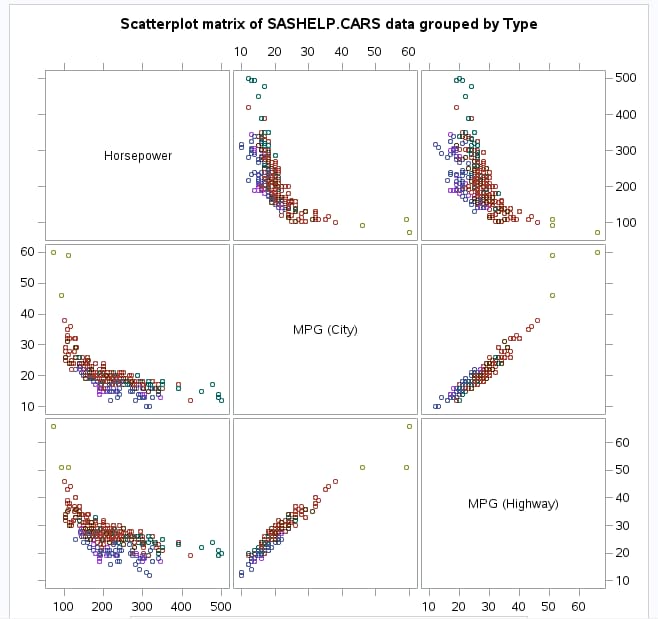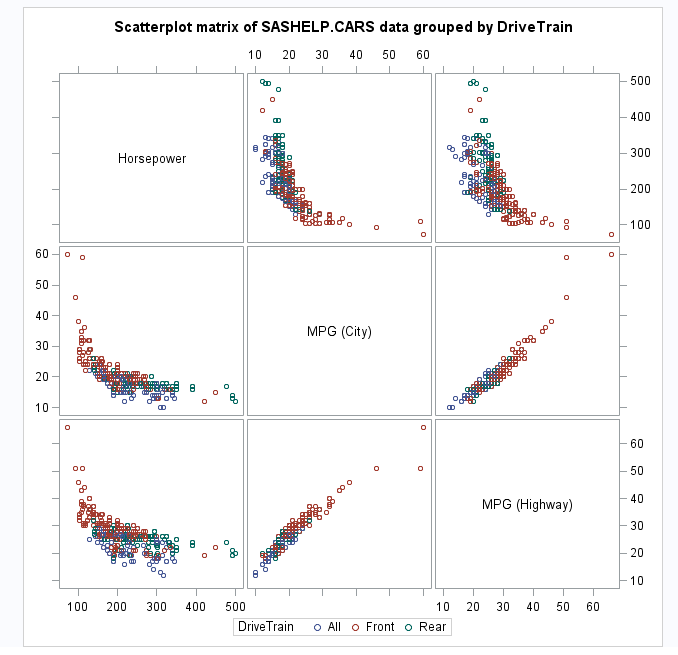Data Exploration Task
Assigning Data to Roles
To run the Data Exploration
task, you must assign either two columns to the Classification
variables role or one column to the Continuous
variables role.
|
Role
|
Description
|
|---|---|
|
Roles
|
|
|
Classification
variables
|
specifies the classification
variables to use to explore the data.
|
|
Continuous
variables
|
specifies the continuous
variables in the analysis.
|
|
Additional Roles
|
|
|
Group analysis
by
|
creates separate analyses
based on the number of BY variables.
|
Setting the Plot Options
The plot options that
are available depend on the columns that you assigned on the Data tab.
|
Option Name
|
Description
|
|---|---|
|
Histogram and Box Plot
|
|
|
The combined histogram
and box plot options are available when a column is assigned to the Continuous
variables role, but no column is assigned to the Classification
variables role.
|
|
|
Scatter Plot Matrix
|
|
|
The scatter plot matrix
options are available when at least two columns are assigned to the Continuous
variables role.
|
|
|
Add histograms
|
adds histograms to the
diagonal cells of the matrix. You can add a normal density curve and
the kernel density estimate to these histograms.
|
|
Add prediction
ellipses
|
adds a prediction ellipse
to each cell that contains a scatter plot. You can specify the confidence
level for the ellipses. Valid values are between 0 and 1.
|
|
Pairwise Scatter Plots
|
|
|
The pairwise scatter
plot options are available when at least two columns are assigned
to the Continuous variables role.
|
|
|
Pairwise
scatter plots
|
plots the values of
two or more variables and produces a separate cell for each combination
of Y and X variables. That is, each Y*X pair is plotted on a separate
set of axes.
|
|
Add a prediction
ellipse
|
adds a prediction ellipse
to each cell that contains a scatter plot. You can specify the confidence
level for the ellipses. Valid values are between 0 and 1.
|
|
Regression Scatter Plots
|
|
|
The regression scatter
plot options are available when at least two columns are assigned
to the Continuous variables role.
|
|
|
Regression
scatter plots
|
adds a regression fit
to the scatter plot.
|
|
Select response
variables
|
specifies the variables
to use when fitting the regression line.
|
|
Add a fitted
line
|
adds a regression fit
to the scatter plot.
|
|
Add a loess
fit
|
adds a loess fit to
the scatter plot.
|
|
Add a fitted,
penalized B-spline curve
|
adds a fitted, penalized
B-spline curve to the scatter plot.
|
|
Mosaic Plot
|
|
|
Mosaic plot
|
creates a mosaic plot,
which displays tiles that correspond to the crosstabulation table
cells. The areas of the tiles are proportional to the frequencies
of the table cells. The column variable is displayed on the X axis,
and the tile widths are proportional to the relative frequencies of
the column variable levels. The row variable is displayed on the Y
axis, and the tile heights are proportional to the relative frequencies
of the row levels within column levels.
|
|
Square mosaic
plot
|
produces a square mosaic
plot, where the height of the Y axis equals the width of the X axis.
In a square mosaic plot, the scale of the relative frequencies is
the same on both axes.
|
|
Specify
colors of mosaic plot tiles
|
colors the mosaic plot
tiles according to the values of residuals. You can also specify to
color the tiles according to the Pearson or standardized residuals
of the corresponding table cells.
|
|
Histogram
|
|
|
Histogram
|
creates a histogram
by using any numeric variables in the input data set.
|
|
Add normal
density curve
|
adds a normal density
curve to the histogram.
|
|
Add kernel
density estimate
|
adds a kernel density
estimate to the histogram.
|
|
Add inset
statistics
|
adds a box or table
of summary statistics directly in the histogram.
|
|
Box Plot
|
|
|
The box plot options
are available when at least one column is assigned to the Classification
variables role.
|
|
|
Comparative
box plot
|
creates a one-way box
plot for each classification variable. This plot shows all continuous
variables by the classification variable.
|
Copyright © SAS Institute Inc. All rights reserved.


